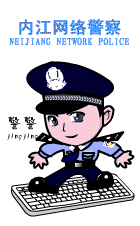The following report from Neijiang, Sichuan was originally published by Radio France Internationale last December in a detailed report on social trends in 2010. Read the original here (scroll down to the middle of section four). Translation by Deng Bolun.
Report from the Neijiang, Sichuan government website: “The Neijiang Bureau of Public Security’s intense work on key online controls has yielded outstanding results.” This material is hard to come by. This “verified record of investigation” has historical value. It is therefore excerpted here in detail:
“In recent years, the Neijiang Public Security Bureau has taken progressive action with its online information system to orchestrate the control of key Internet users, placing those users in positions where they are easily caught. Continuous innovation of ‘online technological war strategy,’ a deeper utilization of early warnings on key people, the improved accuracy of probes on the status of key users and the improvement of our strategy has yielded outstanding results.”
Among these methods are:
“Steady steps in establishing a system: The municipal bureau has invited contractors to conduct research on the establishment of the project and develop a platform suitable for the control of key users in our city, as well as to strengthen intelligence report collection, assessment and utilization.”
“A bureau-wide system for collecting intelligence: We ensure the control of key Internet users goes to the root of their activity, that we have a clear picture of the situation, that our control is not leaked or lost, and that we do not cause damage. From within the bureau, we have strengthened criminal investigation, security and other functions in tracking the activity of key users in relation to accidents, medical disputes, eviction disputes and other daily intelligence. Outside of the bureau (i.e. social information), we have strengthened communication with the departments of sanitation, city planning, industry and commerce, and taxation, with emphasis on information searches concerning the number of household members, places of work, finances and other social status. We coordinate on-the-ground checks for false identification and regulate key users on a daily basis.”
“Strict management of our classifications for monitoring: For A-level users we establish online reconnaissance or control projects and adopt all measures available for intelligence-gathering and long-term control. We limit the space of their online activity. For B-level users we undertake whatever monitoring is necessary, take measures for control, track trends in their activity, and emphasize control. For C-level users we adopt online inspection measures in order to monitor them, promptly incorporate them into our field of vision and avoid harm.”
“Using the excellent opportunity provided by the real-name system at Internet cafes to our advantage: We bring together the telecom and broadband user databases and ensure that we adjust for the difference in the target’s status updates, that we carry out controls on his activity, that we locate trends in the key user’s activity, that the content of this activity is understood, and that it reflects the trends in intelligence reports.”
“Every week the intelligence center carries out analysis and studies on high-risk populations, making pertinent recommendations for prevention and control and guiding basic-level units in scientific vigilance.”
“The bureau divides the investigation of key users among surveillance, case investigation, management and other functions of the People’s Police. For ensure that each department’s ‘grand intelligence’ system successful control and timely evaluation of key users’ activities, we have established a monthly bulletin system and bring in annual performance reports.”
“Strictly manage quality control: As the bureau collects information about key users, we are particular about accuracy and completeness. Information to be collected includes the real name and identification of key users, Internet usage information and online clues which will pass through a chain of reconnaissance, investigation, comparison and excavation, etc.
We take advantage of the key user’s identification numbers, the phone numbers she uses and the her computer MNA address. With the many corresponding online IDs in the fake identification database, we ensure their real and fake identities match.”








